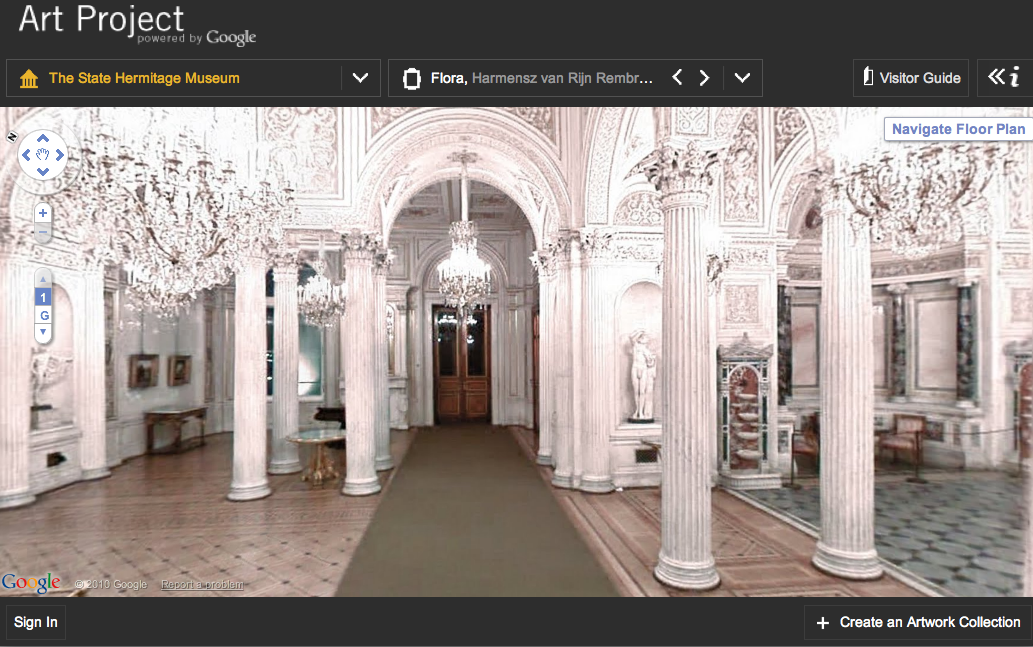A recent NTEN article provided a list of free online tools to help nonprofit organizations test their websites for accessibility. These tools help to ensure the features and content on a website can be experienced by persons of all abilities. Today I take a closer look at one of the tools listed, WAVE, and review another option not included in the report, AMP.
Viewpoints: A New Photo App Centered on the Style of Artist David Datuna
In 2008, Damien Hirst took a decision that raised many eyebrows and caused others to furrow. He bypassed his gallery (Gagosian), and took his works directly to auction at Sotheby’s. While Hirst’s move was as audacious as a shark in formaldehyde, his motivations were probably (mostly) monetary and sensationalistic. Yet the desire to bypass the selectivity of galleries and create awareness or a market for their art is not unique to artists such as Hirst. But while he resorted to a giant of an auction house, artists today can use something as small as an app.
Touring the Louvre with a Nintendo 3DS

The eagerly awaited Nintendo 3DS audio guides arrived at the Louvre in early April. For security reasons, they are not quite the action packed adventure that some may have been hoping for. Nevertheless, the audio guides are a great way to tour the museum and have some neat capabilities.
A recent review by Mike Schramm of Joystiq provides insight on just how Nintendo 3DS has been utilized at the Louvre. As he notes, the audio guide lets visitors explore the museum in three ways; an interactive map, a Masterpieces Tour, or an option called Visit a Must-See Work.
The interactive map highlights points of interest within the museum, which indicate the presence of audio commentary for a particular work. According to Schramm, “Each point of interest on the 3DS' map has at least one bit of audio commentary on it, and sometimes more than that, with various museum officials or professors talking about the work in more depth.”
The second option is the Masterpieces Tour, which will lead you to artworks that have known to draw gasps, tears, and unquestionably, l'humanité en masse. The Masterpieces Tour always keeps apace with you thanks to the 3DS has geolocation capabilities. Those with a tendency to wander will be happy to hear that the audio commentary only begins once you are within the vicinity of the masterpiece. The tour is also flexible in that you can visit other works during your tour; the 3DS will simply (and silently) wait for you to get back on track.
The final option is the Visit a Must-See Work, which will light up a “flashing route line” to a famous artwork nearby. If you happen to be lost, the option acts as a silent distress call, saving you from museological trouble one masterpiece at a time.
The Louvre’s audio guide also makes use of Nintendo’s display and 3D capabilities.“In addition to the audio commentaries, there are 3D photos of the galleries, high-definition images of the artworks, and 3D reconstructions to help you identify the exhibits and give you extra information.” Schramm mentioned how high resolution images of artworks are available on the 3DS, making it easier to explore details on the touch screen. The display is also used to showcase different artworks being compared to the artwork at hand during an audio commentary.
The only drawbacks noted by Schramm were the short battery life and the 3DS’s inability to keep up with location changes of certain pieces. Even so, the Nintendo 3DS is a Super Mario sized step forward in interactivity and audience engagement at the Louvre. In fact, the Nintendo 3DS echoes back to The O at the Museum of Old and New Art (MONA), with its geolocation and touch screen capabilities.
Devices such as The O and the 3DS do more than just guide users, they help them discover. And this sense of discovery is a lot more compelling when users are leading themselves through one of the world’s most visited museums. Nintendo in the Louvre? C’estformidable!
The Royal Opera's The Show Must Go On, Reviewed
has the player assuming the role of a stage manager at a variety of different productions. The degree to which the player succeeds or fails at a series of mini games effects the show itself at the end of the scenario. This game was play tested on a IPad 1 for this review. Fun: (4 out of 5 stars) The game plays well. The characters are charmingly rendered and are well suited to the genre of performing arts that they represent. The music of the show in question plays on cheerfully in the background and was a highlight. There was a good sense of immediacy in the constituent games within each production and as such the overall sense of timing was well designed. The strategies involved in game play were pretty linear and as such may be better suited for a younger audience.
Playability: (4.5 out of 5 stars) The game is quick to learn and master. The constituent games are well suited to the touch interface. Each module within a show has enough different about it to keep most people engaged for hours.
Depth: (2.5 out of 5 stars) The app and the four shows yielded about six and a half hours of game play. The player has to unlock each show in order and can play individual modules in the score attack mode. For an adult player the replay factor is limited after the four show scenarios replay is probably quite a bit better for a younger audience.
Value: (4.5 out of 5 stars) For the price of $.99 this feels like a bargain.
Overall: (4 out of 5 stars) There are a lot of good things going for The Show Must Go On. This app is a fun and easy introduction to four famous shows. The music that plays with the game is lovely, even when played through iPad speakers. I highly recommend checking this app out for killing time during holiday travel, it worked well for me.
Everybody's talking about Google Art Project
Is Google Art Project setting a new standard for the online art world, or is it all just hype? Since its release a few days ago, the public has taken its first stroll through the project’s virtual galleries and in general, first impressions have been enthusiastic.
Birth of Venus
"The Birth of Venus" by Sandro Botticelli. Uffizi Gallery, Florence via Google Art Project
Arts lovers are all abuzz about its fabulous image quality, its accessibility to broad audiences, and its educational potential. While it is too early to tell how much of an impact Art Project will actually make on museums and the art world, the collaborative spirit and innovative technology of the site shows great promise.
For the past 18 months, Google has collaborated with 17 world-class museums to create "Street View"-style tours of their permanent collection galleries. While “walking” around a gallery, a virtual museum-goer can zoom in on any one of 1000 artworks. Many of these images are also accompanied by information such as descriptions of the work, artist biographies, links to more in-depth coverage on the museum’s website, and even some informational videos.
The Hermitage Museum via Google Art Project
The State Hermitage Museum, St. Petersburg, Russia via Google Art Project
Even better, one artwork per museum is available in “gigapixel” resolution of up to 14 million pixels so that you can zoom in almost microscopically close to the canvas. This allows for an intensive scrutiny of artwork that has not been previously available online.
In addition, visitors have the option to curate their own virtual collections, including details that are captured by zoom, and comments about the art. These collections can be shared via Facebook, Twitter or embedded link. It’s free, but you’ll need to sign in to a Google account to create your own collections.
Navigating through the virtual galleries can be mesmerizing. Personally, I loved the feeling of revisiting those museum galleries that I hadn’t been to in years. It was a truly moving experience to be able to unlock those visual memories. And for those museums that I haven’t yet visited but have always wanted to see, it was great to get a taste of what visiting might actually feel like.
The Street-View technology at times can be quite cumbersome and frustrating. Often, I found myself stumbling around, bumping into invisible walls, fruitlessly clicking away and trying to back myself out of corners. In addition, the image resolution of the navigation tool can be fuzzy, especially in contrast with the images of the artwork itself.
Starry Night
The “gigapixel” technology is jaw-dropping, and it feels so much more intimate than your run-of-the-mill online image. As Nancy Proctor and Julian Raby of the Smithsonian point out, "to engage with the work of art in this way transforms the web experience from an informational one to an emotive one.” I imagine, and hope, that these super high-resolution images will someday become ubiquitous in online museum collection. While not a substitute for seeing the art in person, these images are breathtaking in their own right. Detail of "Starry Night" by Vincent Van Gogh. MOMA via Google Art Project
Many pieces in the galleries are blurred out due to copyright issues. While this is understandable, it can also be distracting. Furthermore, most of the museums offer very few actual galleries to explore. MOMA, for example, has just one gallery and the lobby. And the lobby doesn’t have any art that is actually visible or accessible to the viewer. Over at Art21, guest blogger Kevin Buist has some interesting thoughts about the uncanny effect of seeing so many doorways into other galleries that in fact are blocked by those invisible walls.
It’s an impressive debut, despite its flaws. Perhaps most exciting is its collaborative approach to making museums accessible to new audiences around the world. While virtual gallery tours have been offered online before, they have existed in isolation from one another. Art Project brings them together in a visually stunning way, where curious users can wander around museums that they didn’t even know existed.
Some have criticized that Google is cherry-picking the museums involved and therefore curating its artistic content, but I would counter that they had to start somewhere. If the Art Project is successful, doubtless they will need to grow their museum roster, especially to include non-western museums. And I suspect that some of those navigational kinks can be worked out over time as well.
It remains to be seen if the Art Project will truly be able to sustain audiences over time, but I hope that it can. Anytime art can reach new audiences in innovative ways, I think that it’s cause for the art sector to celebrate.









